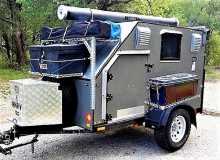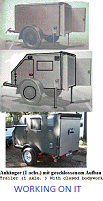external fuel supply for Honda-engined genny
23 posts
• Page 1 of 2 • 1, 2
external fuel supply for Honda-engined genny
I just re-worked my generator slide/swivel mount, and also attempting to build a sound-reducing enclosure for it (it's not a Honda EU "quiet" genny, but a Honda/Craftsman hybrid). I designed the trailer to be able to run the generator to supply power to the A/C, but it only has a small fuel tank, inadequate for more than a couple of hours runtime. I never did get around to making/buying a larger supply tank, so it could run all night if need be. The Honda EUs have special systems made for that, but not my generator. It does have a pulse-driven fuel pump, and the literature on the engine says it can draw/feed fuel up to 19 inches away from the tank, either above or below carb level (of course, I can no longer find the literature). I'm considering adding a feed line (on a tee), with a shut-off valve inline, and another return line to prevent oversupply, and simply dropping the end of the line(s) into my 5 gallon gas can, and run the genny that way. I read that the pulse pump will not overcome the needle/seat setting, but just in case, the return line seems needed. Either with or without a priming bulb? Or should I just add a marine tank, with all the equipment, even a fuel gauge? I really don't know if the pulse pump will actually pull from 12" away, and at a 6" elevation (projected placement on a stand next to it, both inside a soundproofing/cooling box), but I'm not familiar with outboard fuel systems either...it may overfeed the carb anyway. Any thoughts or experience doing this? I'll experiment if not (of course, outdoors, with a fire extinguisher in hand). I've run V-8 engines via a similar method (putting cars on a trailer, in the wild), but on a very short-time basis. I want to be able to run this one while I sleep, unattended, safely.
2013 HHRv "squareback/squaredrop", rugged, 4x8 TTT, 2225 lbs


- *3500 lb Dexter EZ-Lube braked axle, 3000 lb.springs, active-progressive bumpstop suspension
- *27 x 8.5-14LT AT tires (x 3) *Weight Distribution system for single-beam tongue
- *100% LED's & GFCI outlets, 3x fans, AM/FM/CD/Aux. *A/C & heat, Optima AGM, inverter & charger(s)
- *extended-run, on-board, 2500w generator *Coleman dual-fuel stove & lantern, Ikea grill, vintage skillet
- *zinc/stainless front & side racks *98"L x 6" diameter rod & reel carrier tube on roof
-

working on it - 2000 Club

- Posts: 2189
- Images: 457
- Joined: Tue Oct 04, 2011 9:05 pm
- Location: DFW Texas
Re: external fuel supply for Honda-engined genny
Ever thought about dual fuel conversion.... There is company out there somewhere that makes conversion units so you can switch between propane and gas....
https://www.google.com/search?q=dual+fu ... e&ie=UTF-8
Other thoughts on this is, if engine is equipped with pulse driven pump it will probably not over pressure carb as both units are designed to work together...So need for return line is probably not necessary...
The idea of a fuel can sitting there with lid/cap off and a return line just dropped into makes me have a vision of some night critter (raccoon or dog or cat) bumping into it and it falling over and fuel running out onto ground and then a huge vapor cloud capable of causing instantaneous ignition( EXPLOSION)...
If you want external tank get something designed to be used as a fuel tank (marine?)... Idea of squeeze bulb (prime) and a selector valve does have it merits....
Dale
https://www.google.com/search?q=dual+fu ... e&ie=UTF-8
Other thoughts on this is, if engine is equipped with pulse driven pump it will probably not over pressure carb as both units are designed to work together...So need for return line is probably not necessary...
The idea of a fuel can sitting there with lid/cap off and a return line just dropped into makes me have a vision of some night critter (raccoon or dog or cat) bumping into it and it falling over and fuel running out onto ground and then a huge vapor cloud capable of causing instantaneous ignition( EXPLOSION)...
If you want external tank get something designed to be used as a fuel tank (marine?)... Idea of squeeze bulb (prime) and a selector valve does have it merits....
Dale
Lives his life vicariously through his own self.
Any statement made by me are strictly my own opinion.
You are free to ignore anything I say if you do not agree.

Any statement made by me are strictly my own opinion.
You are free to ignore anything I say if you do not agree.

-

Dale M. - 2000 Club

- Posts: 2693
- Images: 18
- Joined: Thu Jun 09, 2005 8:50 pm
- Location: Just a tiny bit west of Yosemite National Park
